3RD TERM
3RD TERM
SCHEME OF WORK
WEEKS TOPIC
1. Managing family clothing: (a) clothing storage (b) clothing repairs
2. Practical Session: Demonstrate and carryout simple clothing repairs.
3. Household linen: (a) Types of household linen, (b) maintenance of household linen
4. The family House: family house functional areas: (i) kitchen and food store, (ii) Dining room (iii) sitting room (iv) Bedroom (v) Toilet and bathroom.
5. Maintenance of the Family House: (a) Equipment and materials for maintenance of the home. (b) Guidelines for house care.
6. Maintenance of the family house: (c) procedures for maintenance of functional areas of the home (d) demonstrate and supervise student’s practice in their hostels.
7. Basic clothing construction:(a) seams and seam finishing- (i) different types of seams, (ii) meaning and types of seam finishes, (iii) making of seams and seam finishes.
8. Basic clothing construction: (b) edge finishes- (i) meaning and types of edge finishes (ii) methods of finishing edges
9. Body measurement: (a) body parts to be measured, (b) guidelines for taking body measurement, (c) procedures for taking body measurements, (d) taking body measurement
10. Basic Pattern Drafting: (a) basic pattern drafting tools and equipment,(b)drafting bodice and skirt patterns
11. Revision
WEEKS TOPIC
1. Managing family clothing: (a) clothing storage (b) clothing repairs
2. Practical Session: Demonstrate and carryout simple clothing repairs.
3. Household linen: (a) Types of household linen, (b) maintenance of household linen
4. The family House: family house functional areas: (i) kitchen and food store, (ii) Dining room (iii) sitting room (iv) Bedroom (v) Toilet and bathroom.
5. Maintenance of the Family House: (a) Equipment and materials for maintenance of the home. (b) Guidelines for house care.
6. Maintenance of the family house: (c) procedures for maintenance of functional areas of the home (d) demonstrate and supervise student’s practice in their hostels.
7. Basic clothing construction:(a) seams and seam finishing- (i) different types of seams, (ii) meaning and types of seam finishes, (iii) making of seams and seam finishes.
8. Basic clothing construction: (b) edge finishes- (i) meaning and types of edge finishes (ii) methods of finishing edges
9. Body measurement: (a) body parts to be measured, (b) guidelines for taking body measurement, (c) procedures for taking body measurements, (d) taking body measurement
10. Basic Pattern Drafting: (a) basic pattern drafting tools and equipment,(b)drafting bodice and skirt patterns
11. Revision
Week 1
TOPIC: MANAGING FAMILY CLOTHING
CONTENT: (a) Clothing Storage
(b) Clothing Repairs
SUB-TOPIC 1: CLOTHING STORAGE
Clothing is any article we place on the body in order to protect, beautify or adorn it. It include dresses, shoes, hats, jewelry, etc. family clothing is very important because it can promote or impair the health of family members.
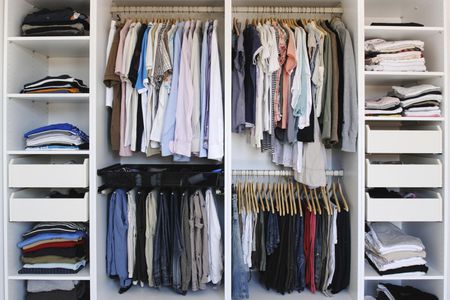
PROPER STORAGE AND CARE OF CLOTHES:
1. Provide a good storage space for your clothes, e.g. a good closet/wardrobe, a box or drawer.
2. Use good quality hangers.
3. Do not store dirty clothes, wash them, dirty clothes attract germs.
4. Air clothes after wear before putting them away.
5. Remove all brooches or pins from clothes before putting away.
6. Do not store clothes that are damp or in a damp place.
7. Mothballs or camphor balls can be placed in the wardrobe or storage boxes or drawers.
8. Keep the wardrobe tidy always, by storing clothes neatly.
9. Clean the wardrobe regularly.
10. Wash your under-wears and socks daily.
11. Do not put perfume onto a garment as it may stain the fabric.
12. Remove spots or stains from clothes as soon as they occur.
13. Never let a garment become too dirty before washing it.
14. Check clothes regularly for loose fastenings, split seam, tear and undone hems.
15. Mend clothes as quickly as possible. This prevents more damage to the article.
16. Take extra time to put garments where they belong when you remove them

METHOD OF STORING FAMILY CLOTHES:
Family clothes can be stored in any of the following ways:
1. Storage in boxes or bags: This method protects clothes from insects, dust, light, and air that is either too humid or too dry.
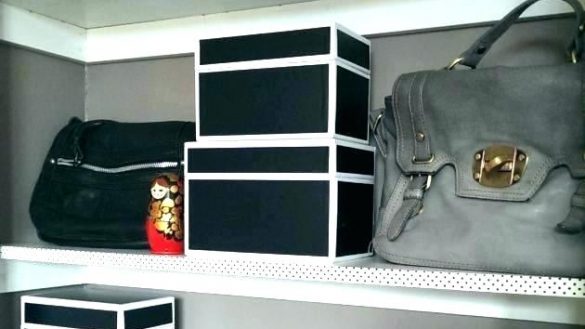
GUIDELINES FOR STORING CLOTHES IN BOXES OR BAGS.
a. Select a good box or bag for your clothes.
b. Store only clean clothes.
c. Iron the clothes before storing them in the box.
d. Store in the box seasonal clothes or those you do not wear often.
e. Fold clothes properly before storing in the box.
f. Place folded clothes carefully in the box. Avoid creasing the clothes.
2. Storage in closets or wardrobe with hangers: hanging clothes in the closets or wardrobe prevents them from getting creased or rumpled.
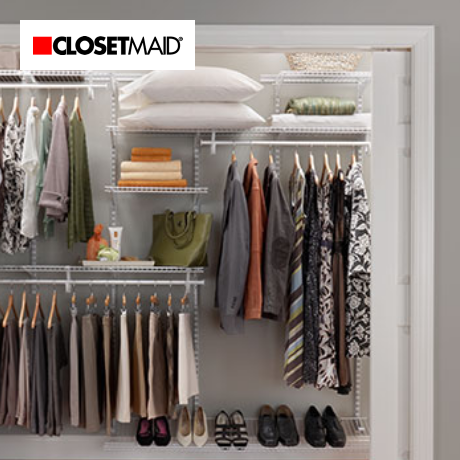
GUIDELINES FOR STORAGE IN CLOSETS OR WARDROBE
a. Use good hangers. Skirts and trousers require special hangers.
b. Do not hang loosely woven fabric articles such as sweaters because they can stretch out shape.
c. Delicate and fine fabric such as silk requires padded hangers.
d. The shoulders of the clothes should be properly eased in and placed on the hangers, zippers closed, buttons (at least the top one) fastened.\
e. Do not overcrowd the wardrobe with clothes so that air can circulate among the clothes.
f. Keep your clothes from dust.
g. Hang similar items together in the closet for ease in finding them.
h. Remove extra hangers from the closet in order to maximize hanging space.
i. Brush and air the clothes frequently to prevent dust and mould.
j. To prevent creases in trousers and skirts, hang them from the waist band on special hangers.
k. Keep some camphor balls in the closet to prevent the entry of insects such as cockroaches.
l. Clean the wardrobe or closet regularly.
3. Storage of clothes in drawers and shelves; certain clothes are best stored in the drawers, e.g. heavy woven sweaters.
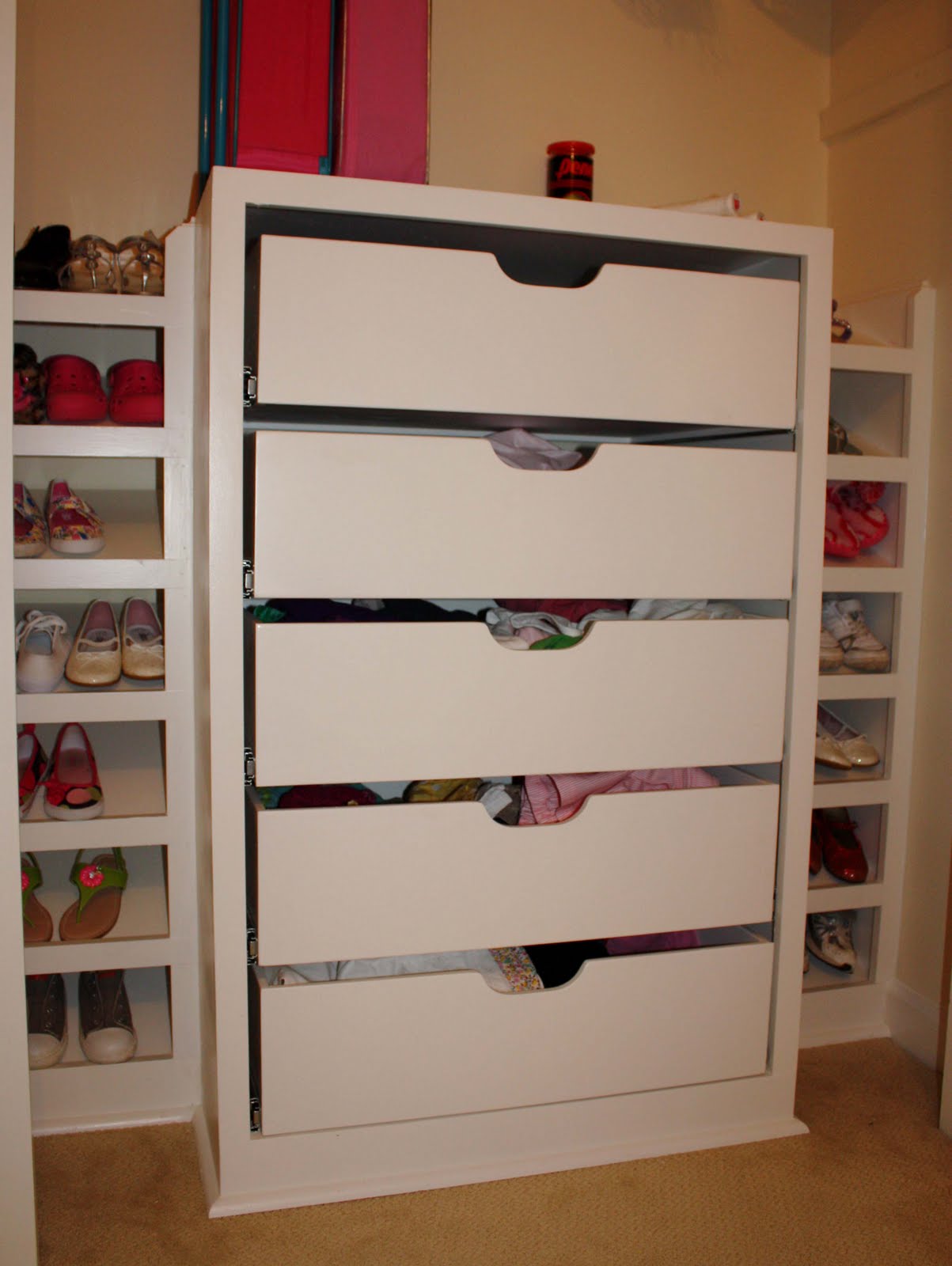
GUIDELINES FOR STORAGE IN DRAWERS OR SHELVES
a. Store only clean and dry clothes in the drawers and shelves.
b. Fold the clothes carefully to remove all creases.
c. Stack the lighter clothes on top of heavy ones to prevent crushing.
d. Keep some camphor balls in the drawers or shelves to keep insect away.
4. Storage of Accessories:
Shoe: do not leave your shoes carelessly on the floor to gather and become more difficult to clean.
Do the following:
a. Clean your shoes after use.
b. Stuff them clean pieces of cloth or paper, to maintain their shapes.
c. Repair your shoes as soon as there is a tear, before storage.
d. Arrange your shoes on a shoe rack or shelf.
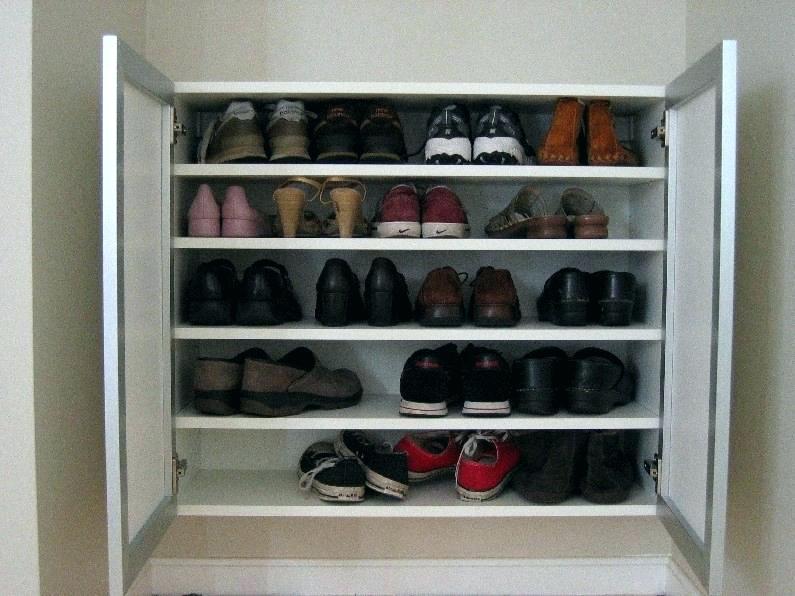
EVALUATION:
1. Mention 10 guidelines for proper storage and care of clothes.
2. List and explain 3 methods the family can store their clothes.
SUB TOPIC 2: CLOTHING REPAIRS
There are different types of clothing repair. These include:
1. Lost or worn fastenings, e.g., buttons and button holes.
a. Sew on any lost or loose buttons.
b. Mend worn buttonholes by stitching over them with buttonhole stitches.
c. Loose and missing fastenings as soon as possible.
[youtube]https://www.youtube.com/watch?v=97cmyBId14A[/youtube]
2. Cut or loose elastic band: the elastic band within your underwear or any part of your garment can cut or become too loose. To mend:
a. Unpick a few stitches of the casing for the elastic from the wrong side.
b. Pull out the old elastic.
c. Replace with new elastic pulling through the casing with a suitable safety pin.
d. Over-sew the ends of the elastic firmly together.
e. Neatly re-stitch the casing.
[youtube]https://www.youtube.com/watch?v=HepCT5-OVVg[/youtube]
3. Loose or split seam and undone hems;
a. Tack the seam or hem with a matching thread.
b. Use running stitch or backstitch for split seam and hemming stitch for hems.
c. Start stitching a little (about 2.5cm) before the loose area and sew into the unsplit side.
[youtube]https://www.youtube.com/watch?v=5xSi_z2xG8M[/youtube]
4. Darning: this is the process of mending or repairing a knitted or woven article by wearing thread into the fabric to replace or strengthen torn or worn threads.
[youtube]https://www.youtube.com/watch?v=FJJJoMhmuPI[/youtube]
WEEKLY ASSIGNMENT: Popoola O.O. Workbook on Home Economics New Concepts Book 2, unit 7, Page 15 – 16.
CONTENT: (a) Clothing Storage
(b) Clothing Repairs
SUB-TOPIC 1: CLOTHING STORAGE
Clothing is any article we place on the body in order to protect, beautify or adorn it. It include dresses, shoes, hats, jewelry, etc. family clothing is very important because it can promote or impair the health of family members.

PROPER STORAGE AND CARE OF CLOTHES:
1. Provide a good storage space for your clothes, e.g. a good closet/wardrobe, a box or drawer.
2. Use good quality hangers.
3. Do not store dirty clothes, wash them, dirty clothes attract germs.
4. Air clothes after wear before putting them away.
5. Remove all brooches or pins from clothes before putting away.
6. Do not store clothes that are damp or in a damp place.
7. Mothballs or camphor balls can be placed in the wardrobe or storage boxes or drawers.
8. Keep the wardrobe tidy always, by storing clothes neatly.
9. Clean the wardrobe regularly.
10. Wash your under-wears and socks daily.
11. Do not put perfume onto a garment as it may stain the fabric.
12. Remove spots or stains from clothes as soon as they occur.
13. Never let a garment become too dirty before washing it.
14. Check clothes regularly for loose fastenings, split seam, tear and undone hems.
15. Mend clothes as quickly as possible. This prevents more damage to the article.
16. Take extra time to put garments where they belong when you remove them

METHOD OF STORING FAMILY CLOTHES:
Family clothes can be stored in any of the following ways:
1. Storage in boxes or bags: This method protects clothes from insects, dust, light, and air that is either too humid or too dry.

GUIDELINES FOR STORING CLOTHES IN BOXES OR BAGS.
a. Select a good box or bag for your clothes.
b. Store only clean clothes.
c. Iron the clothes before storing them in the box.
d. Store in the box seasonal clothes or those you do not wear often.
e. Fold clothes properly before storing in the box.
f. Place folded clothes carefully in the box. Avoid creasing the clothes.
2. Storage in closets or wardrobe with hangers: hanging clothes in the closets or wardrobe prevents them from getting creased or rumpled.

GUIDELINES FOR STORAGE IN CLOSETS OR WARDROBE
a. Use good hangers. Skirts and trousers require special hangers.
b. Do not hang loosely woven fabric articles such as sweaters because they can stretch out shape.
c. Delicate and fine fabric such as silk requires padded hangers.
d. The shoulders of the clothes should be properly eased in and placed on the hangers, zippers closed, buttons (at least the top one) fastened.\
e. Do not overcrowd the wardrobe with clothes so that air can circulate among the clothes.
f. Keep your clothes from dust.
g. Hang similar items together in the closet for ease in finding them.
h. Remove extra hangers from the closet in order to maximize hanging space.
i. Brush and air the clothes frequently to prevent dust and mould.
j. To prevent creases in trousers and skirts, hang them from the waist band on special hangers.
k. Keep some camphor balls in the closet to prevent the entry of insects such as cockroaches.
l. Clean the wardrobe or closet regularly.
3. Storage of clothes in drawers and shelves; certain clothes are best stored in the drawers, e.g. heavy woven sweaters.

GUIDELINES FOR STORAGE IN DRAWERS OR SHELVES
a. Store only clean and dry clothes in the drawers and shelves.
b. Fold the clothes carefully to remove all creases.
c. Stack the lighter clothes on top of heavy ones to prevent crushing.
d. Keep some camphor balls in the drawers or shelves to keep insect away.
4. Storage of Accessories:
Shoe: do not leave your shoes carelessly on the floor to gather and become more difficult to clean.
Do the following:
a. Clean your shoes after use.
b. Stuff them clean pieces of cloth or paper, to maintain their shapes.
c. Repair your shoes as soon as there is a tear, before storage.
d. Arrange your shoes on a shoe rack or shelf.

EVALUATION:
1. Mention 10 guidelines for proper storage and care of clothes.
2. List and explain 3 methods the family can store their clothes.
SUB TOPIC 2: CLOTHING REPAIRS
There are different types of clothing repair. These include:
1. Lost or worn fastenings, e.g., buttons and button holes.
a. Sew on any lost or loose buttons.
b. Mend worn buttonholes by stitching over them with buttonhole stitches.
c. Loose and missing fastenings as soon as possible.
[youtube]https://www.youtube.com/watch?v=97cmyBId14A[/youtube]
2. Cut or loose elastic band: the elastic band within your underwear or any part of your garment can cut or become too loose. To mend:
a. Unpick a few stitches of the casing for the elastic from the wrong side.
b. Pull out the old elastic.
c. Replace with new elastic pulling through the casing with a suitable safety pin.
d. Over-sew the ends of the elastic firmly together.
e. Neatly re-stitch the casing.
[youtube]https://www.youtube.com/watch?v=HepCT5-OVVg[/youtube]
3. Loose or split seam and undone hems;
a. Tack the seam or hem with a matching thread.
b. Use running stitch or backstitch for split seam and hemming stitch for hems.
c. Start stitching a little (about 2.5cm) before the loose area and sew into the unsplit side.
[youtube]https://www.youtube.com/watch?v=5xSi_z2xG8M[/youtube]
4. Darning: this is the process of mending or repairing a knitted or woven article by wearing thread into the fabric to replace or strengthen torn or worn threads.
[youtube]https://www.youtube.com/watch?v=FJJJoMhmuPI[/youtube]
WEEKLY ASSIGNMENT: Popoola O.O. Workbook on Home Economics New Concepts Book 2, unit 7, Page 15 – 16.
Week 2
TOPIC: PRACTICAL SESSION
CONTENT: Demonstrate and carryout simple clothing repairs
SUB-TOPIC 1.DEMONSTRATE AND CARRYOUT SIMPLE CLOTHING REPAIRS.
Students should demonstrate the various clothing repairs at home.
[youtube]https://www.youtube.com/watch?v=TPNWP0MFsoY[/youtube]
CONTENT: Demonstrate and carryout simple clothing repairs
SUB-TOPIC 1.DEMONSTRATE AND CARRYOUT SIMPLE CLOTHING REPAIRS.
Students should demonstrate the various clothing repairs at home.
[youtube]https://www.youtube.com/watch?v=TPNWP0MFsoY[/youtube]
Week 3
TOPIC: HOUSEHOLD LINEN
CONTENT: (i) Types of household linen
(ii) Maintenance of household linen
SUB –TOPIC 1: TYPES OF HOUSEHOLD LINEN
Household linen is a term used collectively to include a variety of textiles articles used in the home. It includes bed sheets, pillow cases, blankets, curtains, table cloths, kitchen linen and bathroom linen.
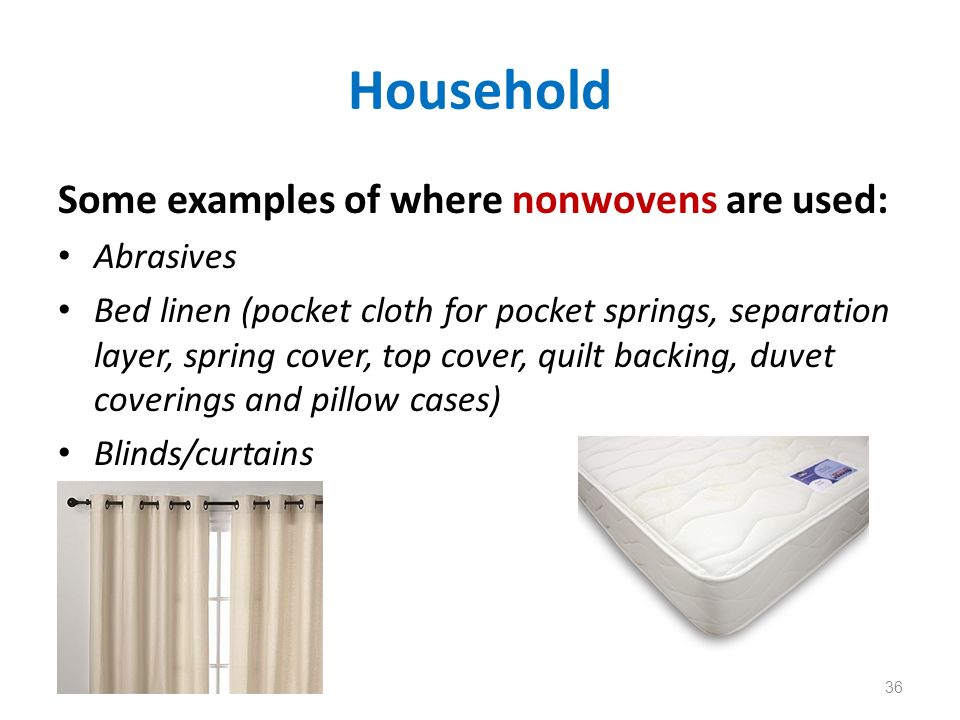
TYPES OF HOUSEHOLD LINEN
1. Curtain and draperies: these are fabrics or materials used for decorating our doors and windows.
Uses of curtains and draperies:
a. They shade the room by room excessive light and wind.
b. They beautify the room by adding colour to it.
c. They provide privacy for families.
d. They establish the character and mood of a room.
e. They can be used to cover special areas or items such as books stored in an open book rack or shoes in a shoe rack.

Curtains
2. Bed linen: Bed linen includes all the different types of fabric materials used to make the bed. They include:
a. Mattress covers: used for covering the mattress in order to protect it from dust and dirt.
b. Bed sheets; used for making the bed.
c. Pillow cases; used for covering the pillows.
d. Bed spreads: used as spread over a made bed and as a covering for the person lying on the bed.
e. Blankets; used as a covering for warmth in cold nights.
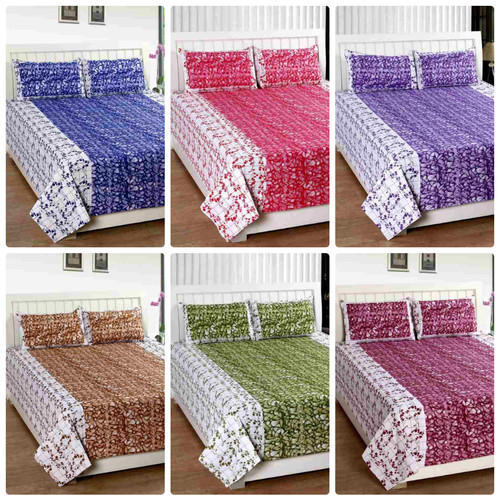
Bed linen
3. Table linen: Table linen refers to all clothes, and mats used on the table. This include:
a. Table cloth: used for covering the table.
b. Place mats; used on the table for setting a cover. The cover refers to the place set for one person on the dining table.
c. Table napkins; used during meals for protecting your dress and for wiping the mouth and hands.
d. Tray/trolley: clothes for laying on the tray/trolley before placing the dishes.
e. Tea clothes: used for wiping or cleaning the table.
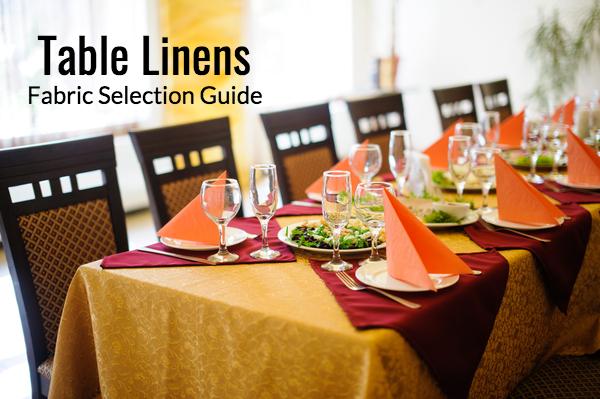
Table Linen
4. Bathroom linen: this is made up of,
a. Bath-towels: they are of various types, they are used for wiping the body dry after bath.
b. Face-towels: these are smaller than bath-towels. They are for cleaning the face.
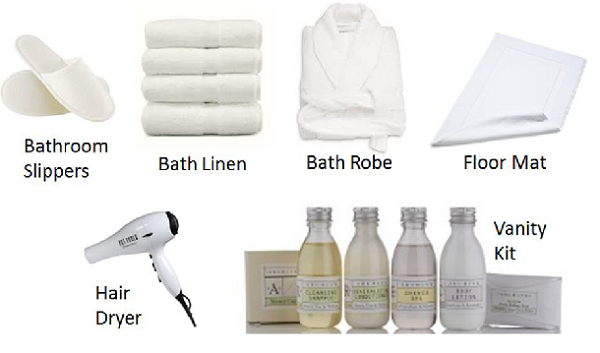
Bathroom linen
5. Kitchen linen: Kitchen linen is made up of the different cloths used in the kitchen for various purposes. They include:
a. Hand towels: These are used for wiping and drying hands.
b. Dish cloth: These are lint-less or non fluffy clothes used for:
(i) Wiping off spills on kitchen surfaces.
(ii) Wiping washed surfaces or equipment such as sinks, tables and work areas.
c. Oven gloves or cloths: These are often padded and used for taking out hot pans and dishes from the oven or top of the cooker.
d. Glass cloth: This is also lint-less and is used for wiping washed glass-wares, e.g. tumblers and dishes.
e. Tea towels: Used for:
a. Blotting off water or moisture from vegetables and fruits.
b. Wiping glass-wares, crockery and cutlery.
Muslin: This is a light loosely woven fabric used for:
(a) Straining during food preparation, e.g. in the preparation of starch or coconut milk or soya bean milk.
(b) Covering food.
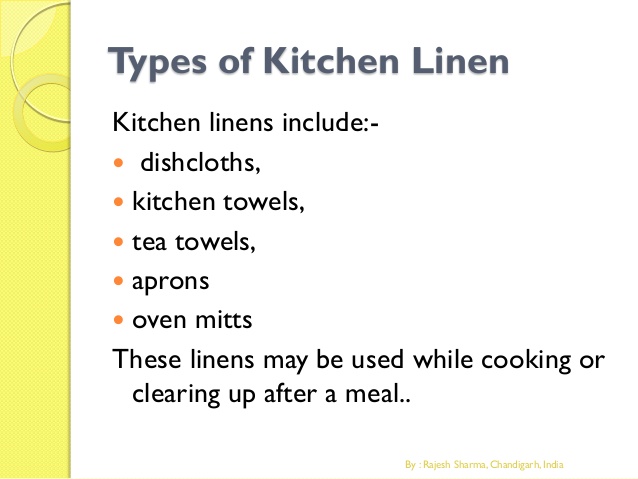
CARE OF KITCHEN LINEN LINE:
1. Wash each kitchen linen after use.
2. Remove any special stains properly.
3. Dry the linen in the sun if possible.
4. Iron the linen.
5. Store linen properly.
6. Provide a suitable space for the storage of kitchen linen.
7. Replace each kitchen linen when it is badly worn out.
EVALUATION:
1. What is household linen?
2. List and explain 4 types of household linen.
SUB – TOPIC 2: MAINTENANCE OF HOUSEHOLD LINEN.
1. Dirty or soiled linen such as bed sheets should be kept in a covered basket or laundry bag until they can be laundered.
2. Some linen such as napkins and floor cloths should be washed immediately after each use.
3. Care must be taken to remove all stains during the washing process.
4. Washed linen should be properly ironed.
5. Air the linen properly.
6. Fold the aired linen properly.
7. Heavy linen such as bed sheets should be stored in dry airy shelves in a cupboard. Storage shelves should be strong.
8. Small light articles, such as tea cloths, napkins, place-mat, may be kept in drawers.
9. Cover stored linen with muslin or other suitable material to prevent dust from settling on them.
10. Similar articles, e.g. sheets, pillow cases, towels, etc. should be kept together.
11. Mend the linen as soon as a tear is noticed.
12. Keep linen in good repair as long as possible.
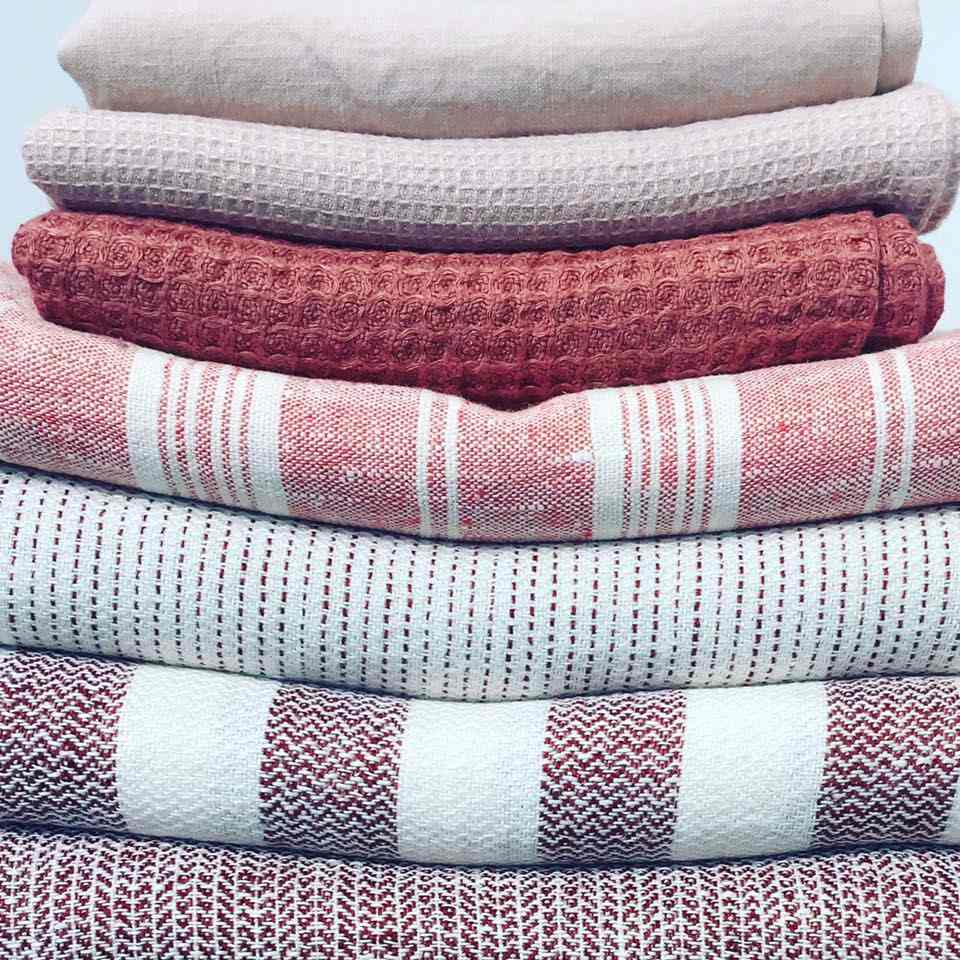
WEEKLY ASSIGNMENT: New concept work book by popoola pg. 14, unit 6
CONTENT: (i) Types of household linen
(ii) Maintenance of household linen
SUB –TOPIC 1: TYPES OF HOUSEHOLD LINEN
Household linen is a term used collectively to include a variety of textiles articles used in the home. It includes bed sheets, pillow cases, blankets, curtains, table cloths, kitchen linen and bathroom linen.

TYPES OF HOUSEHOLD LINEN
1. Curtain and draperies: these are fabrics or materials used for decorating our doors and windows.
Uses of curtains and draperies:
a. They shade the room by room excessive light and wind.
b. They beautify the room by adding colour to it.
c. They provide privacy for families.
d. They establish the character and mood of a room.
e. They can be used to cover special areas or items such as books stored in an open book rack or shoes in a shoe rack.

Curtains
2. Bed linen: Bed linen includes all the different types of fabric materials used to make the bed. They include:
a. Mattress covers: used for covering the mattress in order to protect it from dust and dirt.
b. Bed sheets; used for making the bed.
c. Pillow cases; used for covering the pillows.
d. Bed spreads: used as spread over a made bed and as a covering for the person lying on the bed.
e. Blankets; used as a covering for warmth in cold nights.

Bed linen
3. Table linen: Table linen refers to all clothes, and mats used on the table. This include:
a. Table cloth: used for covering the table.
b. Place mats; used on the table for setting a cover. The cover refers to the place set for one person on the dining table.
c. Table napkins; used during meals for protecting your dress and for wiping the mouth and hands.
d. Tray/trolley: clothes for laying on the tray/trolley before placing the dishes.
e. Tea clothes: used for wiping or cleaning the table.

Table Linen
4. Bathroom linen: this is made up of,
a. Bath-towels: they are of various types, they are used for wiping the body dry after bath.
b. Face-towels: these are smaller than bath-towels. They are for cleaning the face.

Bathroom linen
5. Kitchen linen: Kitchen linen is made up of the different cloths used in the kitchen for various purposes. They include:
a. Hand towels: These are used for wiping and drying hands.
b. Dish cloth: These are lint-less or non fluffy clothes used for:
(i) Wiping off spills on kitchen surfaces.
(ii) Wiping washed surfaces or equipment such as sinks, tables and work areas.
c. Oven gloves or cloths: These are often padded and used for taking out hot pans and dishes from the oven or top of the cooker.
d. Glass cloth: This is also lint-less and is used for wiping washed glass-wares, e.g. tumblers and dishes.
e. Tea towels: Used for:
a. Blotting off water or moisture from vegetables and fruits.
b. Wiping glass-wares, crockery and cutlery.
Muslin: This is a light loosely woven fabric used for:
(a) Straining during food preparation, e.g. in the preparation of starch or coconut milk or soya bean milk.
(b) Covering food.

CARE OF KITCHEN LINEN LINE:
1. Wash each kitchen linen after use.
2. Remove any special stains properly.
3. Dry the linen in the sun if possible.
4. Iron the linen.
5. Store linen properly.
6. Provide a suitable space for the storage of kitchen linen.
7. Replace each kitchen linen when it is badly worn out.
EVALUATION:
1. What is household linen?
2. List and explain 4 types of household linen.
SUB – TOPIC 2: MAINTENANCE OF HOUSEHOLD LINEN.
1. Dirty or soiled linen such as bed sheets should be kept in a covered basket or laundry bag until they can be laundered.
2. Some linen such as napkins and floor cloths should be washed immediately after each use.
3. Care must be taken to remove all stains during the washing process.
4. Washed linen should be properly ironed.
5. Air the linen properly.
6. Fold the aired linen properly.
7. Heavy linen such as bed sheets should be stored in dry airy shelves in a cupboard. Storage shelves should be strong.
8. Small light articles, such as tea cloths, napkins, place-mat, may be kept in drawers.
9. Cover stored linen with muslin or other suitable material to prevent dust from settling on them.
10. Similar articles, e.g. sheets, pillow cases, towels, etc. should be kept together.
11. Mend the linen as soon as a tear is noticed.
12. Keep linen in good repair as long as possible.

WEEKLY ASSIGNMENT: New concept work book by popoola pg. 14, unit 6
Week 4
TOPIC: THE FAMILY HOUSE
CONTENT: 1. Family house functional areas:
( a) kitchen and food store, dining room and sitting room
(b) bed room, toilet and bathroom.
SUB-TOPIC 1: SITTING ROOM, DINING ROOM, KITCHEN AND STORE ROOM.
In any family house there are different rooms or areas. The rooms or areas of the family house that are furnished and used for different functions are called the functional rooms or areas of the house. These include; the kitchen, dining room, bedroom, toilet and bathroom.
SITTING OR LIVING ROOM
This is one of the functional areas in the home.
USES:
1. It is used as a relaxation centre for family members.
2. It is used for receiving and entertaining visitors.
3. Part of it can be used as dining area.
4. Family pictures and other precious collations can be displayed there.
5. It can be used or social activities, such as, parties, meetings, etc.
SITTING ROOM FURNITURE:
1. A set of settee or chairs.
2. A coffee or centre table.
3. A set of side stools.
4. Wall cabinet or room divider, book shelf.
5. Optional items such as, television, radio, etc.
The sitting room also requires floor coverings, curtains and other decoration accessories.

Sitting room
DINING ROOM
This is the functional area of the home where the family members eat their meal. It can be a separate room or part of the room.
USES:
1. It is used as a center for family meals.
2. It can be used for serving meals to visitors.
Furniture found in the dining room include:
1. Dining chairs
2. Tables
3. Side board or cupboard for storing cutlery, glasses, table mats, linens, etc. foods items and drinks such as beverages can be stored in the side- board.

Dining room
KITCHEN:
This is a functional area of the home. It is used as centre for,
1. Food storage
2. Food preparation and cooking.
3. Meal service.
TYPES OF KITCHEN
1. TRADITIONAL KITCHENS: these are common in rural areas and are characterized by the following :
Following:
a. They are built as separate units from the main house.
b. The floor is commonly mud but some are concrete.
c. The shelves or kitchen racks are commonly made of wood or bamboo. The shelves are built above the fire place.
d. Common fuels used are firewood, charcoal or coal.
e. The open drainage system is often used.
f. The fire place can be any of the following:
i. Fixed, e.g. clay cookers.
ii. Movable, e.g. metal tripod.
iii. Three big stones arranged in a triangular position.

Traditional kitchen
2. MODERN KITCHENS: these are common with modern buildings. They are characterized by the following:
i. They are part of the main building and often next to the dining area or room.
ii. Their floors are commonly concrete, terrazzo or tiled.
iii. They have fixtures such as sink, tap, draining board, cabinets, and shelves.
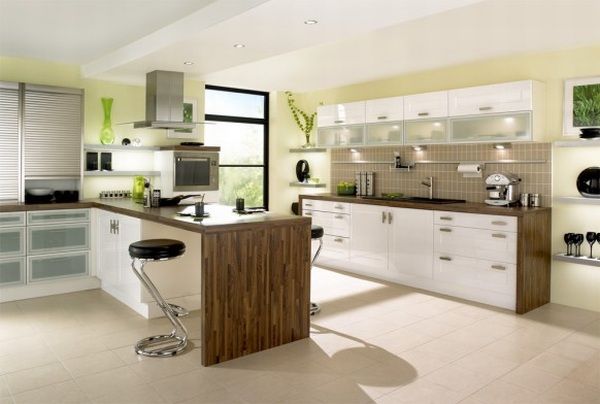
Modern kitchen
FURNITURE OR FIXTURES FOUND IN THE KITCHEN INCLUDE:
a. The cooker
b. Storage cupboard with shelves.
c. Sink with draining board.
d. Kitchen table and chair.
e. Kitchen table and chair.
f. Refrigerator and deep freezers, where they can be afforded.
g. Pestle and mortal.
h. Cooking pots and pans, blenders, assorted kitchen utensils and appliances.
EVALUATION:
What are the uses of ;
1. The sitting room?
2. The dining room?
3. The kitchen?
CONTENT: 1. Family house functional areas:
( a) kitchen and food store, dining room and sitting room
(b) bed room, toilet and bathroom.
SUB-TOPIC 1: SITTING ROOM, DINING ROOM, KITCHEN AND STORE ROOM.
In any family house there are different rooms or areas. The rooms or areas of the family house that are furnished and used for different functions are called the functional rooms or areas of the house. These include; the kitchen, dining room, bedroom, toilet and bathroom.
SITTING OR LIVING ROOM
This is one of the functional areas in the home.
USES:
1. It is used as a relaxation centre for family members.
2. It is used for receiving and entertaining visitors.
3. Part of it can be used as dining area.
4. Family pictures and other precious collations can be displayed there.
5. It can be used or social activities, such as, parties, meetings, etc.
SITTING ROOM FURNITURE:
1. A set of settee or chairs.
2. A coffee or centre table.
3. A set of side stools.
4. Wall cabinet or room divider, book shelf.
5. Optional items such as, television, radio, etc.
The sitting room also requires floor coverings, curtains and other decoration accessories.

Sitting room
DINING ROOM
This is the functional area of the home where the family members eat their meal. It can be a separate room or part of the room.
USES:
1. It is used as a center for family meals.
2. It can be used for serving meals to visitors.
Furniture found in the dining room include:
1. Dining chairs
2. Tables
3. Side board or cupboard for storing cutlery, glasses, table mats, linens, etc. foods items and drinks such as beverages can be stored in the side- board.

Dining room
KITCHEN:
This is a functional area of the home. It is used as centre for,
1. Food storage
2. Food preparation and cooking.
3. Meal service.
TYPES OF KITCHEN
1. TRADITIONAL KITCHENS: these are common in rural areas and are characterized by the following :
Following:
a. They are built as separate units from the main house.
b. The floor is commonly mud but some are concrete.
c. The shelves or kitchen racks are commonly made of wood or bamboo. The shelves are built above the fire place.
d. Common fuels used are firewood, charcoal or coal.
e. The open drainage system is often used.
f. The fire place can be any of the following:
i. Fixed, e.g. clay cookers.
ii. Movable, e.g. metal tripod.
iii. Three big stones arranged in a triangular position.

Traditional kitchen
2. MODERN KITCHENS: these are common with modern buildings. They are characterized by the following:
i. They are part of the main building and often next to the dining area or room.
ii. Their floors are commonly concrete, terrazzo or tiled.
iii. They have fixtures such as sink, tap, draining board, cabinets, and shelves.

Modern kitchen
FURNITURE OR FIXTURES FOUND IN THE KITCHEN INCLUDE:
a. The cooker
b. Storage cupboard with shelves.
c. Sink with draining board.
d. Kitchen table and chair.
e. Kitchen table and chair.
f. Refrigerator and deep freezers, where they can be afforded.
g. Pestle and mortal.
h. Cooking pots and pans, blenders, assorted kitchen utensils and appliances.
EVALUATION:
What are the uses of ;
1. The sitting room?
2. The dining room?
3. The kitchen?
Week 5
SUB-TOPIC 2: BED ROOM, TOILET, BATHROOM
BED ROOM
This is the functional area in the home used as:
a. A place for sleeping or resting.
b. A place for keeping important personal belongings, such as money, document, clothes, jewelry, etc.
c. A center for dressing and making up.
d. Bed room furniture:
i. Bed: this is made with different types of materials.
ii. Mattress: this can be just foam or form with spring interior.
iii. Wardrobe or closet: this can be inbuilt or huge cupboard.
iv. A dressing table: this usually has a mirror mounted on it and a chest of drawers for storage.
v. A stool; this goes with dressing table.
vi. Bed side cupboard; this can either be a part of the bed stand or a separate unit. It is used for storage.
FURNITURE AND FIXTURES FOR THE BEDROOM INCLUDE;
1. Mattresses
2. Pillows
3. Wardrobe or chests of drawers for clothes.
4. Bed linens
5. Dressing table with mirror and stool.

Bed room
BATHROOM: There are tradition and modern bathrooms.
TRADITIONAL BATHROOM:
Common features;
1. It is built as a separate unit form the main house.
2. It usually has no roof
3. It is a small area that can be fenced with palm fronds, corrugated iron sheets or mud blocks.
4. The floor can be with large pieces of stone or a large plank. It can also be concrete or graveled.
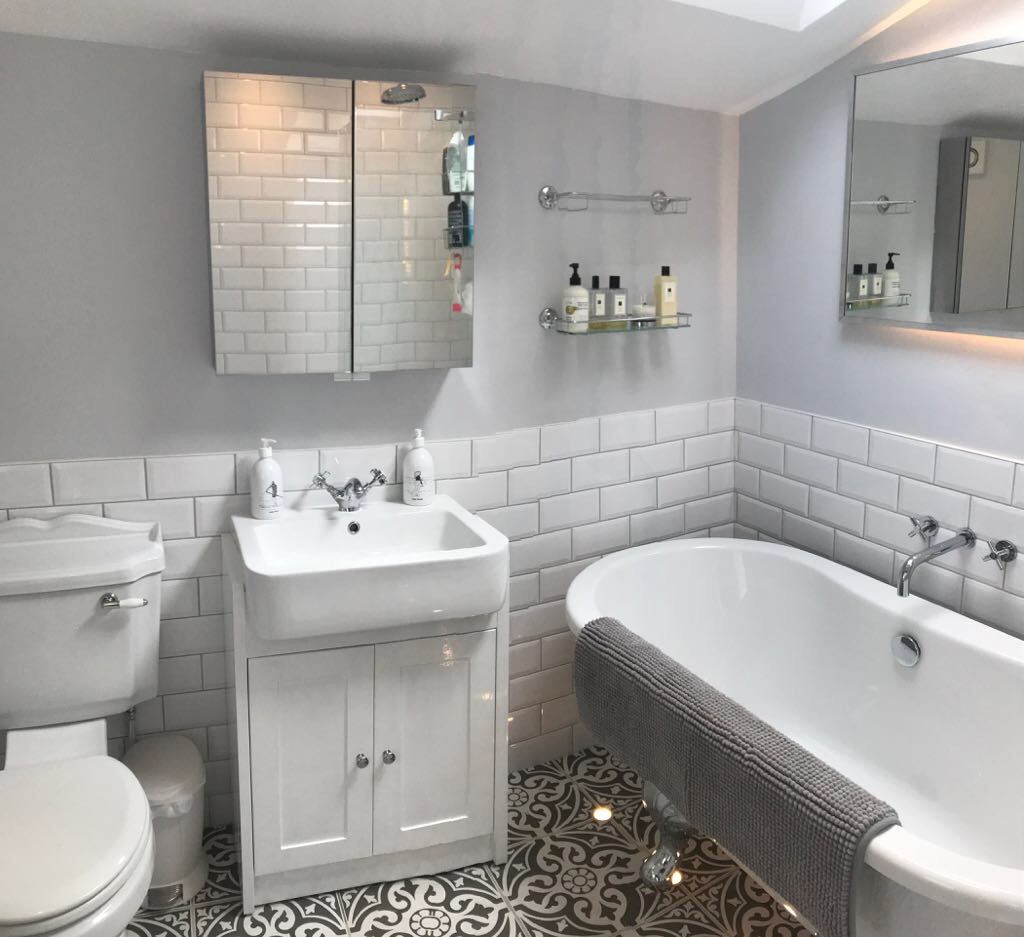
MODERN BATHROOM:
This can be a room attached to the main house. It can be a fenced space like the open air type.
Common features of the modern bathroom include:
1. It is fitted with a shower.
2. The floor is often concrete.
3. It has drainage to lead off the waste water.
4. It is common in boarding houses or schools.

TOILET:
Modern toilet or water closet toilet (WC)
Common features;
1. It is normally part of the main house.
2. It requires water for flushing out the waste matter, each time it is used.
3. The water closet (WC) is made up of:
a. The bowl with a seat and a fitting cover.
b. A cistern or small water tank.
c. Connecting pipes.

The pit latrine or toilet
Common features:
1. It is made up of a pit covered with concrete slabs or strong planks and provided with an opening. This opening must have a well fitting cover or lid. The depth of the pit can vary from 4-6 meters.
2. It should be built some distance away from the house, but not near water well.
3. The floor could be concrete, wooden or mud.
4. There is normally a roof which could be thatched of corrugated iron sheets.
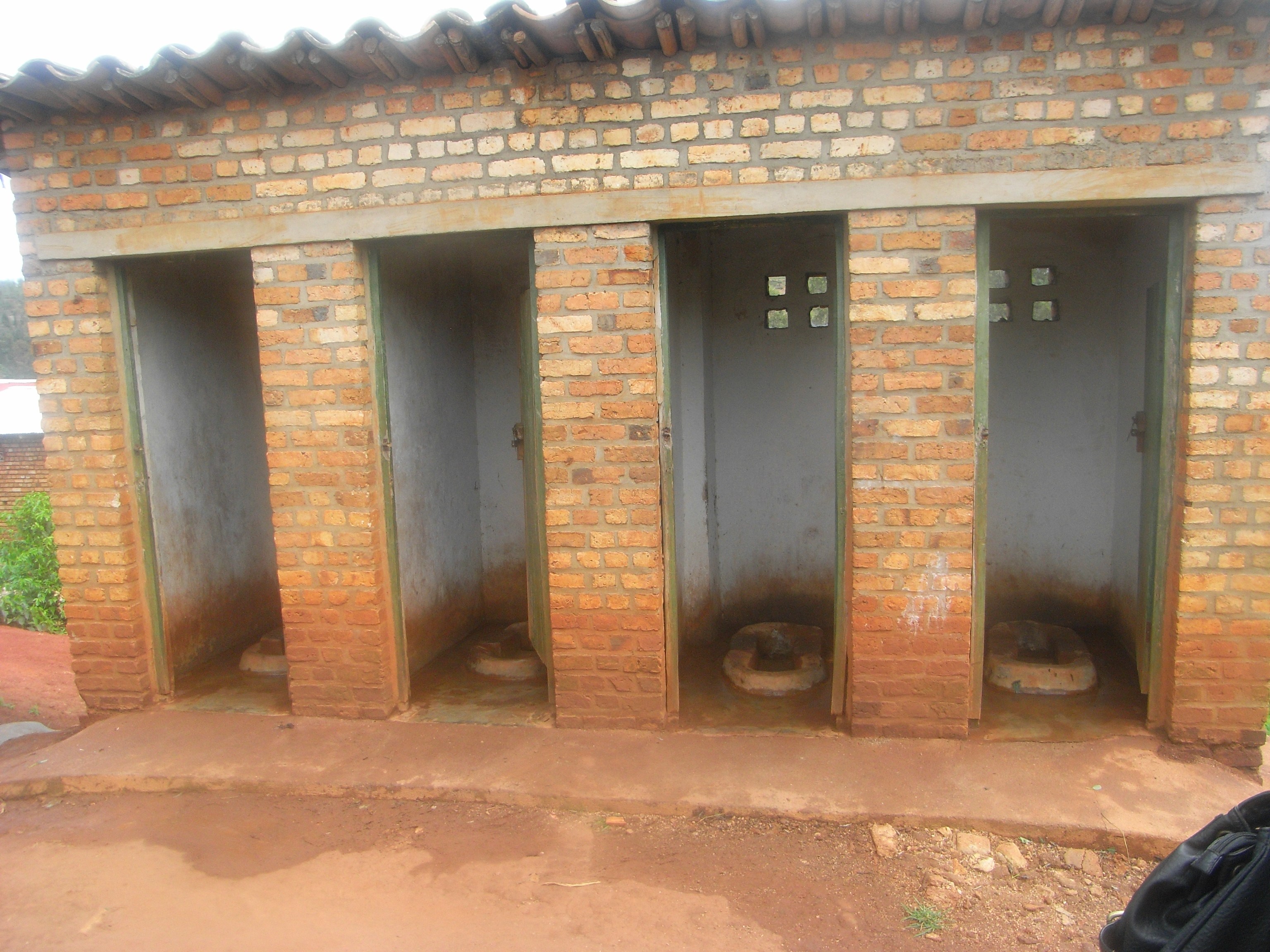
WEEKLY ASSIGNMENT: New concept work book by popoola pg. 8-11, unit 4
BED ROOM
This is the functional area in the home used as:
a. A place for sleeping or resting.
b. A place for keeping important personal belongings, such as money, document, clothes, jewelry, etc.
c. A center for dressing and making up.
d. Bed room furniture:
i. Bed: this is made with different types of materials.
ii. Mattress: this can be just foam or form with spring interior.
iii. Wardrobe or closet: this can be inbuilt or huge cupboard.
iv. A dressing table: this usually has a mirror mounted on it and a chest of drawers for storage.
v. A stool; this goes with dressing table.
vi. Bed side cupboard; this can either be a part of the bed stand or a separate unit. It is used for storage.
FURNITURE AND FIXTURES FOR THE BEDROOM INCLUDE;
1. Mattresses
2. Pillows
3. Wardrobe or chests of drawers for clothes.
4. Bed linens
5. Dressing table with mirror and stool.

Bed room
BATHROOM: There are tradition and modern bathrooms.
TRADITIONAL BATHROOM:
Common features;
1. It is built as a separate unit form the main house.
2. It usually has no roof
3. It is a small area that can be fenced with palm fronds, corrugated iron sheets or mud blocks.
4. The floor can be with large pieces of stone or a large plank. It can also be concrete or graveled.

MODERN BATHROOM:
This can be a room attached to the main house. It can be a fenced space like the open air type.
Common features of the modern bathroom include:
1. It is fitted with a shower.
2. The floor is often concrete.
3. It has drainage to lead off the waste water.
4. It is common in boarding houses or schools.

TOILET:
Modern toilet or water closet toilet (WC)
Common features;
1. It is normally part of the main house.
2. It requires water for flushing out the waste matter, each time it is used.
3. The water closet (WC) is made up of:
a. The bowl with a seat and a fitting cover.
b. A cistern or small water tank.
c. Connecting pipes.

The pit latrine or toilet
Common features:
1. It is made up of a pit covered with concrete slabs or strong planks and provided with an opening. This opening must have a well fitting cover or lid. The depth of the pit can vary from 4-6 meters.
2. It should be built some distance away from the house, but not near water well.
3. The floor could be concrete, wooden or mud.
4. There is normally a roof which could be thatched of corrugated iron sheets.

WEEKLY ASSIGNMENT: New concept work book by popoola pg. 8-11, unit 4
Week 6
TOPIC: MAINTENANCE OF THE FAMILY HOUSE
CONTENT: i. Equipment and materials for maintenance of the home
ii. Guidelines for house care
SUB TOPIC 1: EQUIPMENT AND MATERIALS FOR MAINTENANCE OF THE HOME.
Equipment and materials for household maintenance are used for removing dust and dirt from various articles and surfaces in the home. As a home-maker you should learn about these materials can be able to use them very well. There are also different types of cleaning agents and equipment. Some agents are harmful to one type of surface but good for others. There are also many commercial cleaning agents. Others can be home-made. Before you start cleaning the surface, you should first learn about cleaning agents and equipment.
CLASSES OF CLEANING AGENTS:
Cleaning agents can be classified as, solvents, detergents, abrasives, alkalis, bleaches, polishes and waxes.
1. Solvents are substances which remove dirt liquefying it and holding it in suspension e.g. water, grease solvent.
2. Detergents, synthetic detergents and soap e.g. soap. These emulsifying grease. They aid the removal of grease and dirt.
3. Abrasive cleaners clean by rubbing off dirt through friction, e.g. vim, sand-paper.
4. Alkaline cleaners combine readily with greasy dirt. They reduce the amount of rubbing needed for cleaning, e.g. borax.
5. Acidic cleaners can remove tarnish from copper e.g. vinegar, lemon or lime juice.
6. Waxes are in different forms and brands. They are used to protect surfaces and improve appearance.
7. Polishes are applied to surfaces, such as, wood to improve appearance.
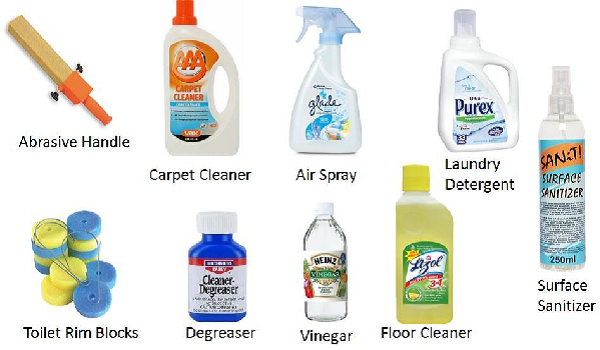
Classes of Cleaning Agents, Examples and Uses:
The Classes of Cleaning Agents
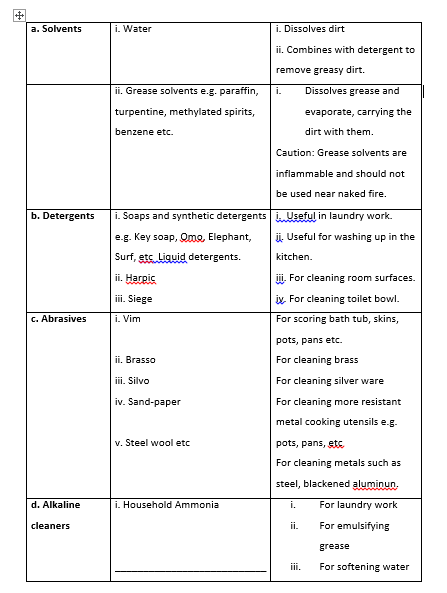
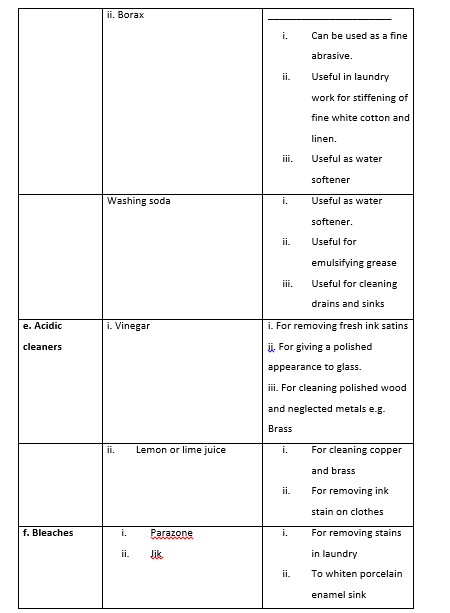

HOME MADE CLEANING AGENTS:
Different materials can be obtained or produced in the home and used as cleaning agents. These include:
1. Fine Sand: This can be sued as an abrasive for cleaning pots. It should be used on smooth surfaces to avoid scratching.
2. “Edo” powder: This is a yellow coloured substance that is common in Nigeria markets. It has a fine smooth texture. It can be used for cleaning ornaments, such as, copper, gold and brass.
3. Finely ground charcoal: This can be used for cleaning smooth metal surfaces.
4. Paw-paw leaves: Fresh paw-paw leaves can be used for cleaning dirty galvanized pails and blackened aluminium pans and pots.
5. Local sand-paper leaves (Asisa leaves): These leaves have rough sandy surfaces. They can used as abrasive for cleaning plain wood surface, blackened pots, etc
6. Home –made “Vim” or scouring powder (Abrasive)
Activity: Demonstrate and practicalize this at home.
Evaluation:
List and explain the classes of cleaning agents
SUB TOPIC 2: GUIDELINES FOR HOUSE CARE
1. Always set apart some time for daily, weekly and seasonal cleaning of the house.
2. Carry out daily, weekly, and occasional cleaning of the different functional areas of the home.
3. Use the correct house cleaning materials or agents for specific surfaces.
4. Use house and vacuum cleaning equipment and tools such as mops, broom cleaners properly.
5. Household waste should be properly disposed of on daily basis.
6. Always keep the surroundings of the houses clean
7. Store house cleaning equipment and materials properly and out of the reach of the children.
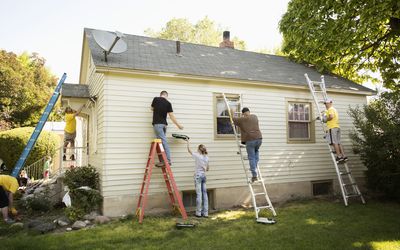
WEEKLY ASSIGNMENT: New concept work book by popoola pg. 5-7, unit 3
CONTENT: i. Equipment and materials for maintenance of the home
ii. Guidelines for house care
SUB TOPIC 1: EQUIPMENT AND MATERIALS FOR MAINTENANCE OF THE HOME.
Equipment and materials for household maintenance are used for removing dust and dirt from various articles and surfaces in the home. As a home-maker you should learn about these materials can be able to use them very well. There are also different types of cleaning agents and equipment. Some agents are harmful to one type of surface but good for others. There are also many commercial cleaning agents. Others can be home-made. Before you start cleaning the surface, you should first learn about cleaning agents and equipment.
CLASSES OF CLEANING AGENTS:
Cleaning agents can be classified as, solvents, detergents, abrasives, alkalis, bleaches, polishes and waxes.
1. Solvents are substances which remove dirt liquefying it and holding it in suspension e.g. water, grease solvent.
2. Detergents, synthetic detergents and soap e.g. soap. These emulsifying grease. They aid the removal of grease and dirt.
3. Abrasive cleaners clean by rubbing off dirt through friction, e.g. vim, sand-paper.
4. Alkaline cleaners combine readily with greasy dirt. They reduce the amount of rubbing needed for cleaning, e.g. borax.
5. Acidic cleaners can remove tarnish from copper e.g. vinegar, lemon or lime juice.
6. Waxes are in different forms and brands. They are used to protect surfaces and improve appearance.
7. Polishes are applied to surfaces, such as, wood to improve appearance.

Classes of Cleaning Agents, Examples and Uses:
The Classes of Cleaning Agents



HOME MADE CLEANING AGENTS:
Different materials can be obtained or produced in the home and used as cleaning agents. These include:
1. Fine Sand: This can be sued as an abrasive for cleaning pots. It should be used on smooth surfaces to avoid scratching.
2. “Edo” powder: This is a yellow coloured substance that is common in Nigeria markets. It has a fine smooth texture. It can be used for cleaning ornaments, such as, copper, gold and brass.
3. Finely ground charcoal: This can be used for cleaning smooth metal surfaces.
4. Paw-paw leaves: Fresh paw-paw leaves can be used for cleaning dirty galvanized pails and blackened aluminium pans and pots.
5. Local sand-paper leaves (Asisa leaves): These leaves have rough sandy surfaces. They can used as abrasive for cleaning plain wood surface, blackened pots, etc
6. Home –made “Vim” or scouring powder (Abrasive)
Activity: Demonstrate and practicalize this at home.
Evaluation:
List and explain the classes of cleaning agents
SUB TOPIC 2: GUIDELINES FOR HOUSE CARE
1. Always set apart some time for daily, weekly and seasonal cleaning of the house.
2. Carry out daily, weekly, and occasional cleaning of the different functional areas of the home.
3. Use the correct house cleaning materials or agents for specific surfaces.
4. Use house and vacuum cleaning equipment and tools such as mops, broom cleaners properly.
5. Household waste should be properly disposed of on daily basis.
6. Always keep the surroundings of the houses clean
7. Store house cleaning equipment and materials properly and out of the reach of the children.

WEEKLY ASSIGNMENT: New concept work book by popoola pg. 5-7, unit 3
Week 7
TOPIC: MAINTENANCE OF THE FAMILY HOUSE
CONTENT: 1. Procedures for maintenance of functional areas of the home.
2. Demonstrate and supervise students’ practice in their hostels.
SUB-TOPIC: 1. PROCEDURES FOR MAINTENANCE OF FUNCTIONAL AREAS OF THE HOME.
An ideal family house should have different areas for the comfort of the family members. The functional
areas of the house include: Sitting room, Dining room, Bedroom, Kitchen and store, Bathroom, Toilet.
There are guidelines to be followed in the maintenance of the family house and there are some
materials to be used.
EQUIPMENT AND MATERIALS NEEDED FOR HOUSEHOLD MAINTENANCE:
Many equipment and materials are needed for care and maintenance of our houses. Some of these
equipment and materials include:
*Brooms and Brushes
*Buckets
*Dust pans
*Mops
*Carpet cleaners
*Dusters
*Floor polish
*Vacuum cleaner

PROCEDURES FOR MAINTENANCE OF FUNCTIONAL AREAS OF THE HOME:
SITTING ROOM:
It is where the family members relax, receive and entertain visitors. The dining room is often part of the
sitting room in some homes. In others it can be a separate room.
i. Always keep doors and windows open for proper ventilation especially when sweeping the room.
ii. Clean the floor according to type.
iii. Arrange furniture for easy movement.
iv. Dust all surfaces, doors, windows and furniture.
v. Empty the waste paper basket. Always keep the rooms clean and tidy.
vi. Clean the flower vase and put in flowers.

DINING ROOM:
It is the functional area where family members eat their meals.
I. Clean the table and table mats properly. Dirty table attracts flies.
II. Sweep the floor properly.
III. Arrange the chairs neatly.
IV. Put fresh flowers in the vase if necessary.
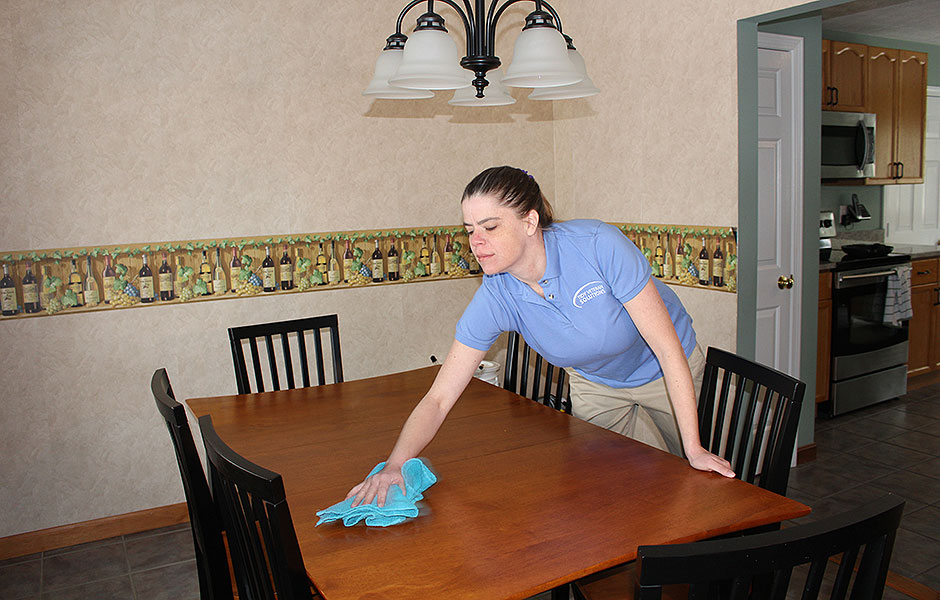
BEDROOM:
Bedroom is the place where we rest, sleep and keep our valuable possessions.
i. Open the windows to air the room.
ii. Sweep the floor and brush the floor covering.
iii. Dust the bedroom furniture.
iv. Make the bed.
v. Arrange the dressing table.
vi. Launder the linens (bed sheets and pillowcases) if they are dirty.
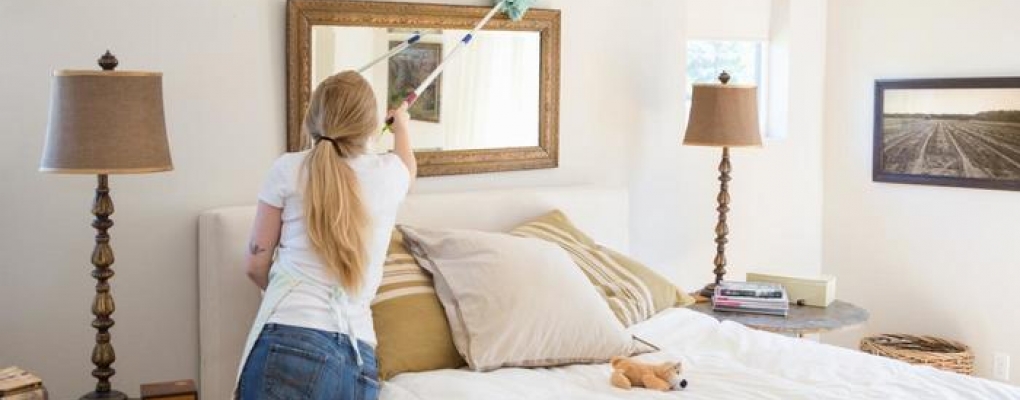
THE KITCHEN AND STORE:
i. Keep the kitchen and the store clean at all times.
ii. Wash plates, pots and cutlery as soon as you finish using them.
iii. Wrap all dirt before putting in the refuse bin to prevent flies from gathering.
iv. Sweep the floor and the food store thoroughly.
v. Arrange foods in the store very well.
vi. Empty the refuse bin.

THE TOILET AND BATHROOM:
i. Clean on daily basis.
ii. If you have a water closet toilet, flush after each use.
iii. Wash the toilet, bath and wash hand-basin constantly.
iv. Clean toilet and bathroom according to type.

GENERAL GUIDELINES FOR MAINTENANCE:
i. Sweep down cobwebs and dust from ceiling and walls.
ii. Distribute furniture evenly in the room.
iii. Always allow cross ventilation by opening doors and windows.
iv. Create time for daily cleaning and weekly cleaning of the house.
v. Keep away pests and cut the grasses around the house.
vi. Dispose of refuse around the house on daily basis.
EVALUATION:
i. List 5 equipment and materials needed for care and maintenance of the house.
ii. Mention three procedures for caring for the bathroom and toilet.
READING ASSIGNMENT:
Popoola, O. O.(2006) Home Economics New Concepts for JSS Book 2, pages 27-41.
ACTIVITY: Draw 2 equipment needed for the care and maintenance of the house.
ASSIGNMENT:
1. Popoola, O.O(2005) Work Book on Home Economics New Concepts JSS 2, Unit 4, pages 8 – 9.
2. Which of the following rooms perform the functions of a dressing room?
(a) The sitting room (b) The living room (c) The bedroom (d) The bathroom
3. .....................is not part of the house to be cared for and maintained.
(a) Kitchen and stores (b) Bathrooms and toilets (c) Various rooms (d) A thick forest
4. Practice the cleaning procedures at home.
CONTENT: 1. Procedures for maintenance of functional areas of the home.
2. Demonstrate and supervise students’ practice in their hostels.
SUB-TOPIC: 1. PROCEDURES FOR MAINTENANCE OF FUNCTIONAL AREAS OF THE HOME.
An ideal family house should have different areas for the comfort of the family members. The functional
areas of the house include: Sitting room, Dining room, Bedroom, Kitchen and store, Bathroom, Toilet.
There are guidelines to be followed in the maintenance of the family house and there are some
materials to be used.
EQUIPMENT AND MATERIALS NEEDED FOR HOUSEHOLD MAINTENANCE:
Many equipment and materials are needed for care and maintenance of our houses. Some of these
equipment and materials include:
*Brooms and Brushes
*Buckets
*Dust pans
*Mops
*Carpet cleaners
*Dusters
*Floor polish
*Vacuum cleaner

PROCEDURES FOR MAINTENANCE OF FUNCTIONAL AREAS OF THE HOME:
SITTING ROOM:
It is where the family members relax, receive and entertain visitors. The dining room is often part of the
sitting room in some homes. In others it can be a separate room.
i. Always keep doors and windows open for proper ventilation especially when sweeping the room.
ii. Clean the floor according to type.
iii. Arrange furniture for easy movement.
iv. Dust all surfaces, doors, windows and furniture.
v. Empty the waste paper basket. Always keep the rooms clean and tidy.
vi. Clean the flower vase and put in flowers.

DINING ROOM:
It is the functional area where family members eat their meals.
I. Clean the table and table mats properly. Dirty table attracts flies.
II. Sweep the floor properly.
III. Arrange the chairs neatly.
IV. Put fresh flowers in the vase if necessary.

BEDROOM:
Bedroom is the place where we rest, sleep and keep our valuable possessions.
i. Open the windows to air the room.
ii. Sweep the floor and brush the floor covering.
iii. Dust the bedroom furniture.
iv. Make the bed.
v. Arrange the dressing table.
vi. Launder the linens (bed sheets and pillowcases) if they are dirty.

THE KITCHEN AND STORE:
i. Keep the kitchen and the store clean at all times.
ii. Wash plates, pots and cutlery as soon as you finish using them.
iii. Wrap all dirt before putting in the refuse bin to prevent flies from gathering.
iv. Sweep the floor and the food store thoroughly.
v. Arrange foods in the store very well.
vi. Empty the refuse bin.

THE TOILET AND BATHROOM:
i. Clean on daily basis.
ii. If you have a water closet toilet, flush after each use.
iii. Wash the toilet, bath and wash hand-basin constantly.
iv. Clean toilet and bathroom according to type.

GENERAL GUIDELINES FOR MAINTENANCE:
i. Sweep down cobwebs and dust from ceiling and walls.
ii. Distribute furniture evenly in the room.
iii. Always allow cross ventilation by opening doors and windows.
iv. Create time for daily cleaning and weekly cleaning of the house.
v. Keep away pests and cut the grasses around the house.
vi. Dispose of refuse around the house on daily basis.
EVALUATION:
i. List 5 equipment and materials needed for care and maintenance of the house.
ii. Mention three procedures for caring for the bathroom and toilet.
READING ASSIGNMENT:
Popoola, O. O.(2006) Home Economics New Concepts for JSS Book 2, pages 27-41.
ACTIVITY: Draw 2 equipment needed for the care and maintenance of the house.
ASSIGNMENT:
1. Popoola, O.O(2005) Work Book on Home Economics New Concepts JSS 2, Unit 4, pages 8 – 9.
2. Which of the following rooms perform the functions of a dressing room?
(a) The sitting room (b) The living room (c) The bedroom (d) The bathroom
3. .....................is not part of the house to be cared for and maintained.
(a) Kitchen and stores (b) Bathrooms and toilets (c) Various rooms (d) A thick forest
4. Practice the cleaning procedures at home.
Week 8
TOPIC: BASIC CLOTHING CONSTRUCTION.
CONTENT 1: Meaning of Seam and seam finishes.
2: Making of seam and types of seam finishes.
SUB-TOPIC 1: MEANING OF SEAM AND SEAM FINISHES
A seam is a line of stitching that joins two or more pieces of cloth. There are different types of seam.
They include the Open or plain, Run-and-fell, French and Lapped seams. Some of the seams have their
raw edges enclosed, for instance the French seam, for others the raw edges are exposed and need to be neatened. This is done by the process called seam finishing.

SEAM FINISHES: are basic sewing processes used to neaten the raw edges of a seam, especially the open
seam.
ADVANTAGES OF SEAM FINISHES
1. It prevents the raw edge from fraying.
2. It prolongs the life of the article.
3. It makes the finished work neat.
4. It gives the garment a professional look.
FACTORS TO CONSIDER WHEN CHOOSING SEAM FINISHING
1. The type of fabric: The type of fabric will determine the seam finishing to be done on them.
2. The use of the garment or articles.
3. Position of the seam. The position of the seam will determine the seam finish to be used e.g. pockets, hem line.
4. Age of the wearer.
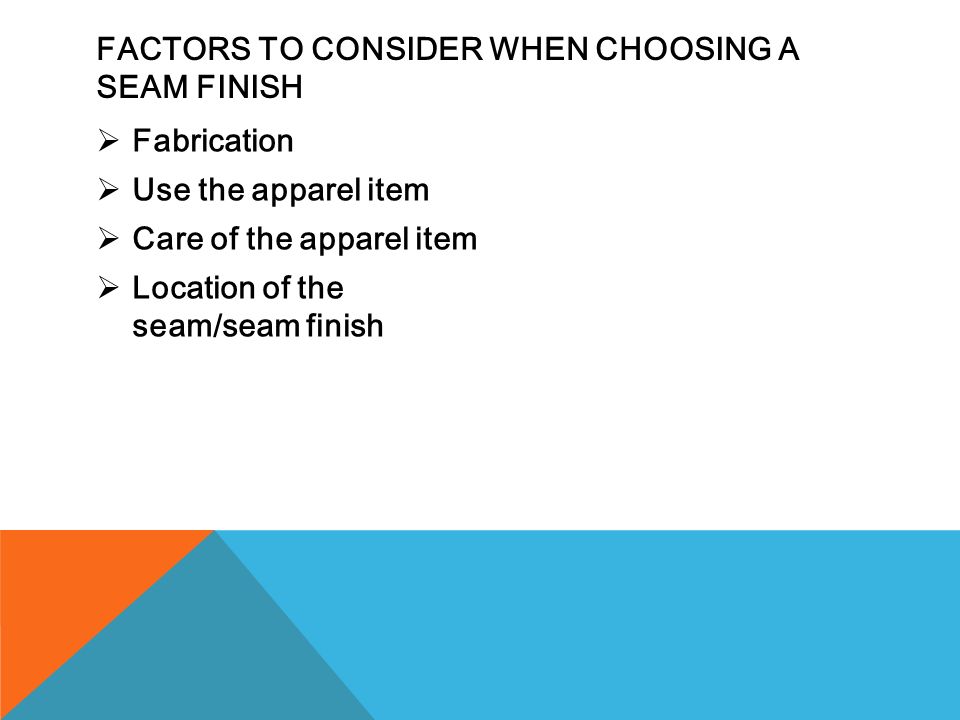
[youtube]https://www.youtube.com/watch?v=og0WnNQym6A[/youtube]
EVALUATION:
1. Explain the meaning of seam finishes.
2. State two advantages of seam finishes.
READING ASSIGNMENT:
Popoola, O.O (2006) Home Economics New concepts for JSS Book 2, pages 130-132.
SUB–TOPIC 2: MAKING OF SEAM AND TYPES OF SEAM FINISHES
MAKING OF SEAMS
OPEN OR PLAIN SEAM: This is the simplest and most commonly used seam. It leaves raw edges that need to be finished or neatened. To make:
i. Place the right sides of material together, mark seam line.
ii. Pin, tack and sew from the wrong side of fabric with proper seam allowance.
iii. Remove tacking thread and press open the seam.
iv. Finish or neaten the raw edges.
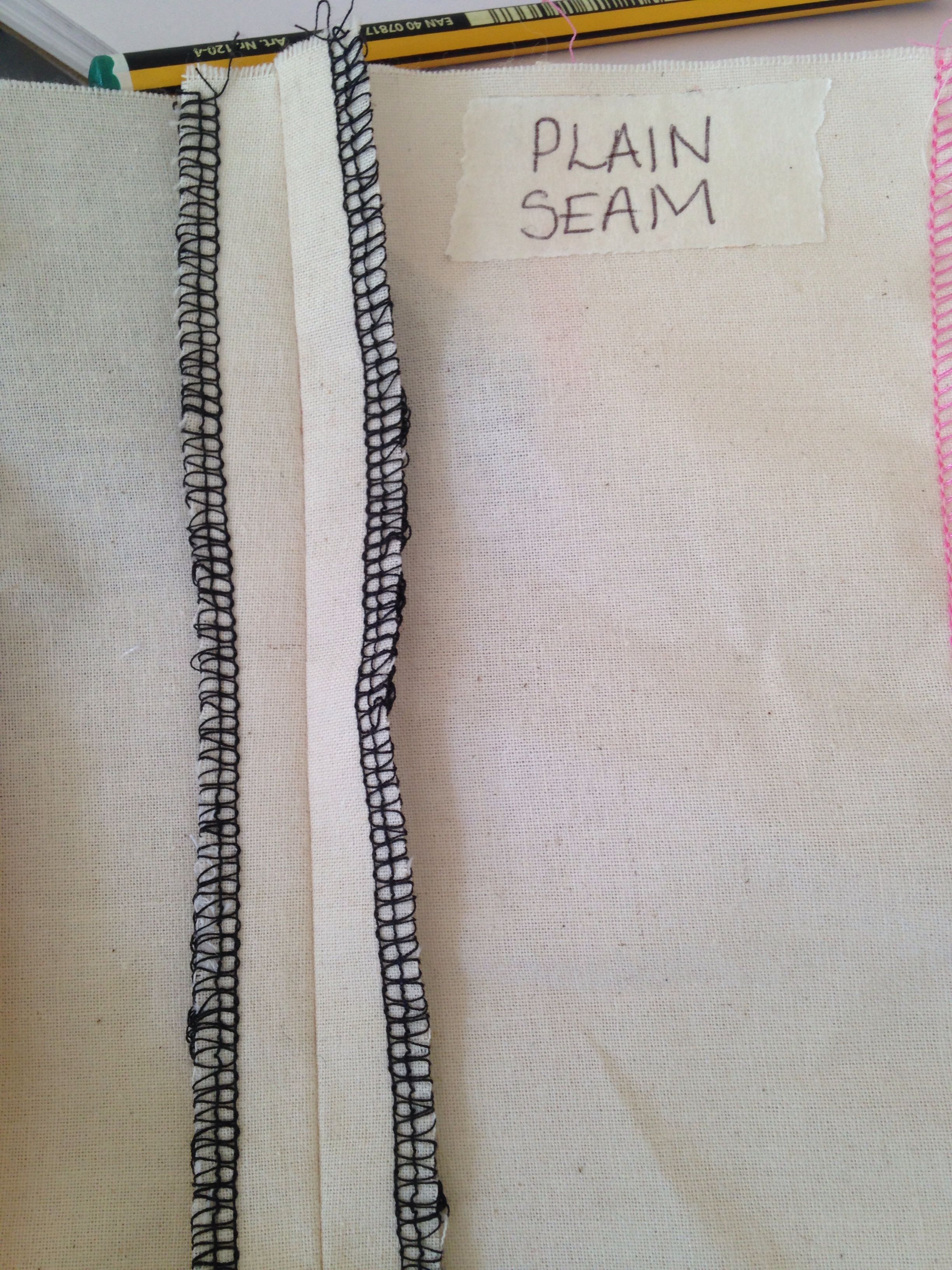
RUN AND FELL SEAM: This is very strong because the seam involves two sets of stitching.
To make:
i. Join two pieces of garment with wrong sides together.
ii. Remove tacking and trim one side to half seam allowance.
iii. Fold the longer seam allowance over the shorter one.
iv. Tack and stitch through.
v. Remove tacking and press flat.

FRENCH SEAM: This is a flat seam. It does not show from the right side. All raw edges are completely enclosed. It does not require extra neatening process.

TYPES OF SEAM FINISHES
There are different methods of finishing seams. These include:
1. Pinking: This is the process of neatening or finishing with pinking shears. It is suitable for bulky fabrics that do not fray.
2. Over casting: This can be done with either hand or machine. It is suitable for all fabrics.
3. Edge stitching: This is machine finishing. It is very neat and strong. It is good for fabrics that fray.
4. Zig-zag finishing: This is made with zig-zag attachment of the sewing machine.
5. Use of trimmings/Bound seam finishing: Lace or bias strip can be used to finish the edge of materials to prevent fraying.
EVALUATION:
1. What is a seam?
2. List four methods of neatening or finishing a seam.
ACTIVITY: Make an album of different types of seam finishes.
[youtube]https://www.youtube.com/watch?v=zwOmmtopkJQ[/youtube]
WEEKLY ASSIGNMENT:
1. Popoola, O.O.(2005) Work Book on Home Economics New concepts, page 31.
2. .................. is any technique used to make a seam edge look neater.
(a) Stitch finish
(b) A seam finish
(c) A French finish
(d) An edge finish
3. The method of seam finishes include the following EXCEPT .....................
(a) Pinking
(b) Zig-zag
(c) Hand overcastting
(d) Open seam
4. Seam finishes prevent the raw edge from.....................
(a) Swelling
(b) Fraying
(c) Sagging
(d) Running
CONTENT 1: Meaning of Seam and seam finishes.
2: Making of seam and types of seam finishes.
SUB-TOPIC 1: MEANING OF SEAM AND SEAM FINISHES
A seam is a line of stitching that joins two or more pieces of cloth. There are different types of seam.
They include the Open or plain, Run-and-fell, French and Lapped seams. Some of the seams have their
raw edges enclosed, for instance the French seam, for others the raw edges are exposed and need to be neatened. This is done by the process called seam finishing.

SEAM FINISHES: are basic sewing processes used to neaten the raw edges of a seam, especially the open
seam.
ADVANTAGES OF SEAM FINISHES
1. It prevents the raw edge from fraying.
2. It prolongs the life of the article.
3. It makes the finished work neat.
4. It gives the garment a professional look.
FACTORS TO CONSIDER WHEN CHOOSING SEAM FINISHING
1. The type of fabric: The type of fabric will determine the seam finishing to be done on them.
2. The use of the garment or articles.
3. Position of the seam. The position of the seam will determine the seam finish to be used e.g. pockets, hem line.
4. Age of the wearer.

[youtube]https://www.youtube.com/watch?v=og0WnNQym6A[/youtube]
EVALUATION:
1. Explain the meaning of seam finishes.
2. State two advantages of seam finishes.
READING ASSIGNMENT:
Popoola, O.O (2006) Home Economics New concepts for JSS Book 2, pages 130-132.
SUB–TOPIC 2: MAKING OF SEAM AND TYPES OF SEAM FINISHES
MAKING OF SEAMS
OPEN OR PLAIN SEAM: This is the simplest and most commonly used seam. It leaves raw edges that need to be finished or neatened. To make:
i. Place the right sides of material together, mark seam line.
ii. Pin, tack and sew from the wrong side of fabric with proper seam allowance.
iii. Remove tacking thread and press open the seam.
iv. Finish or neaten the raw edges.

RUN AND FELL SEAM: This is very strong because the seam involves two sets of stitching.
To make:
i. Join two pieces of garment with wrong sides together.
ii. Remove tacking and trim one side to half seam allowance.
iii. Fold the longer seam allowance over the shorter one.
iv. Tack and stitch through.
v. Remove tacking and press flat.

FRENCH SEAM: This is a flat seam. It does not show from the right side. All raw edges are completely enclosed. It does not require extra neatening process.

TYPES OF SEAM FINISHES
There are different methods of finishing seams. These include:
1. Pinking: This is the process of neatening or finishing with pinking shears. It is suitable for bulky fabrics that do not fray.
2. Over casting: This can be done with either hand or machine. It is suitable for all fabrics.
3. Edge stitching: This is machine finishing. It is very neat and strong. It is good for fabrics that fray.
4. Zig-zag finishing: This is made with zig-zag attachment of the sewing machine.
5. Use of trimmings/Bound seam finishing: Lace or bias strip can be used to finish the edge of materials to prevent fraying.
EVALUATION:
1. What is a seam?
2. List four methods of neatening or finishing a seam.
ACTIVITY: Make an album of different types of seam finishes.
[youtube]https://www.youtube.com/watch?v=zwOmmtopkJQ[/youtube]
WEEKLY ASSIGNMENT:
1. Popoola, O.O.(2005) Work Book on Home Economics New concepts, page 31.
2. .................. is any technique used to make a seam edge look neater.
(a) Stitch finish
(b) A seam finish
(c) A French finish
(d) An edge finish
3. The method of seam finishes include the following EXCEPT .....................
(a) Pinking
(b) Zig-zag
(c) Hand overcastting
(d) Open seam
4. Seam finishes prevent the raw edge from.....................
(a) Swelling
(b) Fraying
(c) Sagging
(d) Running
Week 9
TOPIC: BASIC CLOTHING CONSTRUCTION
CONTENT:
1. Meaning and Types of edge finishes
2. Facing and types
3. Guidelines for making a hem
SUB-TOPIC 1: MEANING AND TYPES OF EDGE FINISHES
FINISHING is the process of neatening the raw edge of articles or garments. The different parts of a garment that require neatening include: the neckline, hems or low edges, open seams, waistlines, armholes etc.
The edge finishing processes include pinking, over-casting, edge-stitching, zig-zag finish and bond finishing.
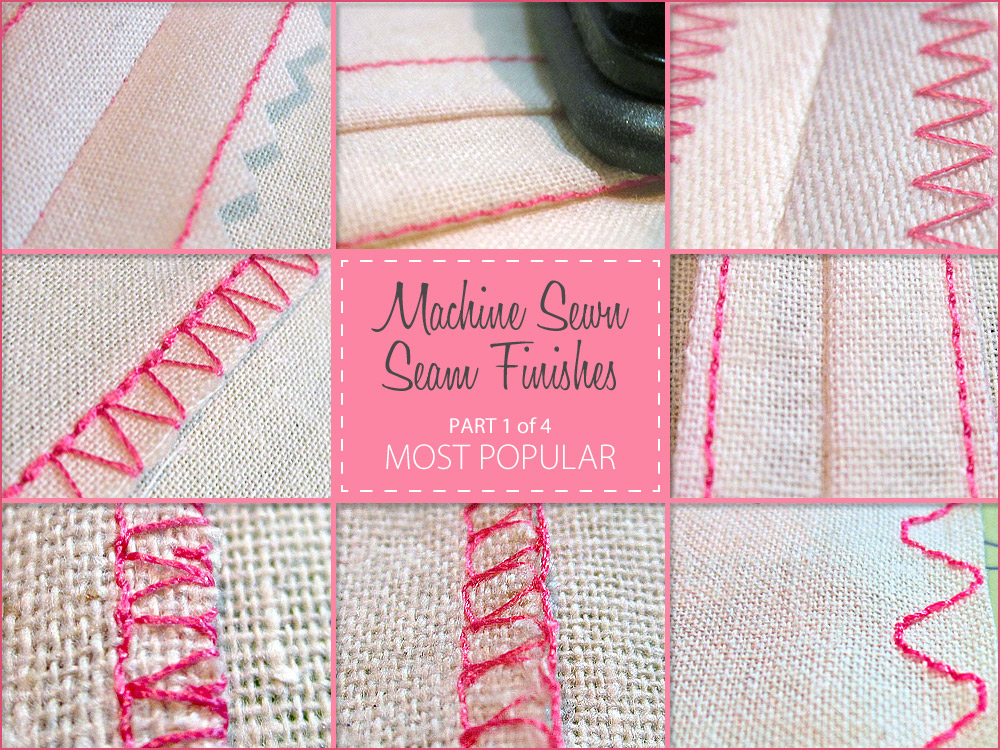
USES OF EDGE FINISHING
1. To neaten the edge of the garment.
2. To secure the edge and prevent fraying of fabric.
3. To decorate an edge e.g. using bias binding for finishing necklines.
POINTS TO CONSIDER IN CHOOSING EDGE FINISHES
1. The type of fabric to be finished e.g. closely woven fabric which do not fray may be finished with pinking shears.
2. The shape of the edge to be finished. For instance curved edges can be finished with bias binding.
3. The purpose of the finishing. It can be for decoration.
4. The style of the garment.
TYPES OF EDGE FINISHES
There are different types of edge finishes. They include:
1. FACING: This involves finishing the raw edges of fabrics or garment with a piece of fabric. Facing shows on only one side of the garment. When facing is turned to the wrong side, it is not seen from the right side. This is called inside facing. When it is finished on the right side of the garment, it called conspicuous or decorative facing.

TYPES OF FACING
i. Straight facing: This is used for neatening the edge of a pocket, a square neck, hem edge of a straight-cut skirt.
ii. Shaped facing: It is usually used for the neckline and armholes.

GUIDELINES FOR ATTACHING FACINGS
i. Facings should be cut to the same shape as the edge of the garment to be faced.
ii. The grain line of the facing should match that of the edge being faced.
iii. The width of the facing should be enough to give a neat, flat finish.
iv. The facing edge and garment edge should be placed exactly together.
v. If facing is to show on right side, put right side of facing to wrong side of garment.
vi. If facing is to appear on the wrong side, place the right side against the right side of garment.
2. Hem: A hem is usually made by folding the edge of a garment to the wrong side twice and sewing it up. Hems are made on the lower edges of blouses, skirts, gowns, trousers e. t. c. If hemming stitch is to be applied, the hem is turned to the wrong side of the garment but if embroidery stitch is used, it is turned to the right side. Hems can be narrow or wide, depending on the style, the garment and the fashion trends.

GUIDELINES FOR MAKING A HEM:
i. Make the hem to look straight and smooth.
ii. Match the seam lines when pining hem into place. Then adjust the fullness between the seams.
iii. Do not make hem bulky.
iv. Ensure that the length of the garment is even when folding for the hem.
v. Insert pins vertically into the hem to ensure that all fullness is evenly distributed.
vi. Make hemming stitches as invisible as possible.
3. BIAS BINDING: This is done by using binding materials.
Procedures for Bias Binding
i. Cut a crossway strip twice the required width and twice the turning allowance in width.
ii. Place the right side of the strip to the right side of the raw edges of garment.
iii. Tack and sew the required width form the edges, stretch the strip slightly while tacking it on.
iv. Make a narrow turning to the wrong side on the free edge of the binding strip.
v. Fold the turned edge over the raw edges to the wrong side of the garment. Tack just above the machine position and sew them into position.
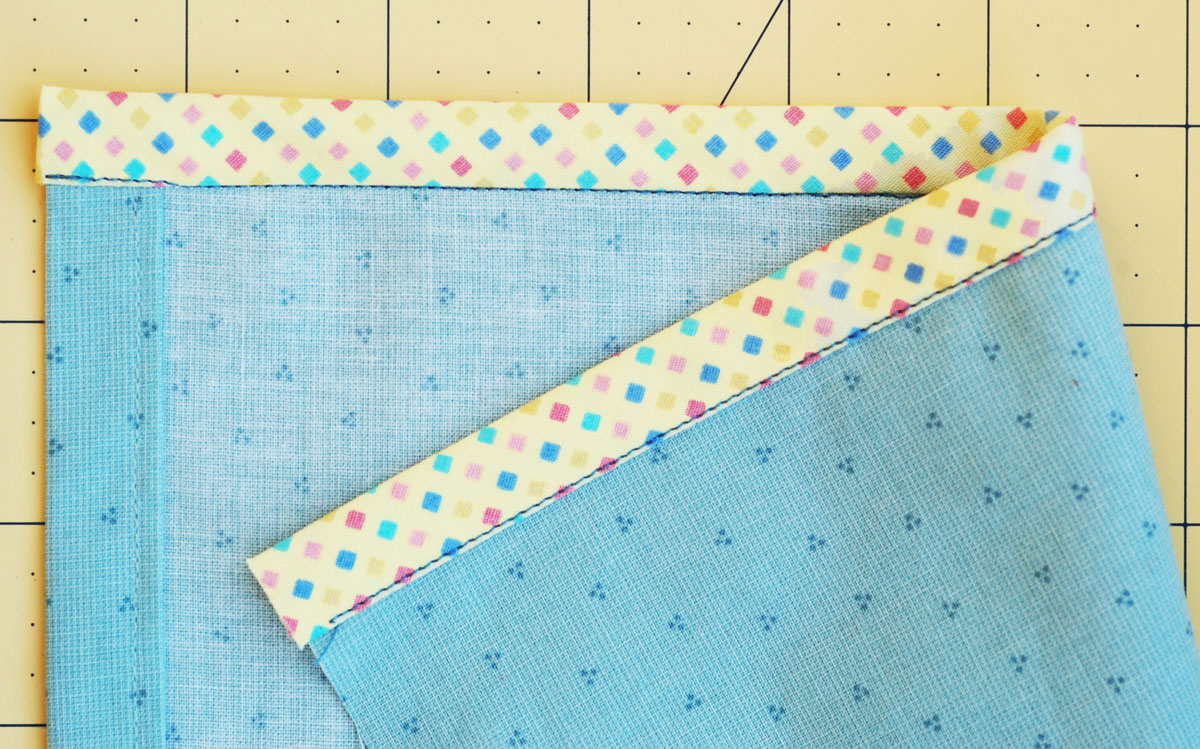
4. USE OF LACE: This can be used in place of a bias binding to neaten or decorate raw edges of fabric. Under wears’ hems, sleeves, necklines are the parts of a garment where lace materials are mostly used.
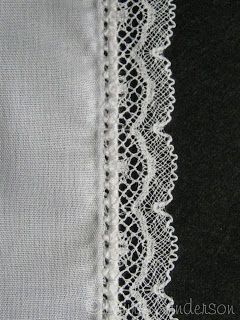
5. PIPING: This is used to finish edges of necklines, cuffs, collars and waistlines.

EVALUATION:
i. What is edge finishes?
ii. State three types of edge finishes.
iii. List two types of facing.
iv. State 3 uses of edge finishes.
ACTIVITIES:
i. Students are to examine their school uniform and indicate the type of edge finishes on them (boys and girls).
ii. Students are to practise edge finishes with the assistance of their teacher. They should use small specimens produced to build up an album of basic sewing processes.
[youtube]https://www.youtube.com/watch?v=HTMTE1tAB9A[/youtube]
[youtube]https://www.youtube.com/watch?v=uFhDl_g7G_k[/youtube]
READING ASSIGNMENT:
Popoola, O.O (2006) Home Economics New Concepts for JSS 2, Unit 15, pages 130 – 137.
ASSIGNMENT:
Popoola, O.O (2005) Work Book on Home Economics New concepts, pages 31 – 32.
CONTENT:
1. Meaning and Types of edge finishes
2. Facing and types
3. Guidelines for making a hem
SUB-TOPIC 1: MEANING AND TYPES OF EDGE FINISHES
FINISHING is the process of neatening the raw edge of articles or garments. The different parts of a garment that require neatening include: the neckline, hems or low edges, open seams, waistlines, armholes etc.
The edge finishing processes include pinking, over-casting, edge-stitching, zig-zag finish and bond finishing.

USES OF EDGE FINISHING
1. To neaten the edge of the garment.
2. To secure the edge and prevent fraying of fabric.
3. To decorate an edge e.g. using bias binding for finishing necklines.
POINTS TO CONSIDER IN CHOOSING EDGE FINISHES
1. The type of fabric to be finished e.g. closely woven fabric which do not fray may be finished with pinking shears.
2. The shape of the edge to be finished. For instance curved edges can be finished with bias binding.
3. The purpose of the finishing. It can be for decoration.
4. The style of the garment.
TYPES OF EDGE FINISHES
There are different types of edge finishes. They include:
1. FACING: This involves finishing the raw edges of fabrics or garment with a piece of fabric. Facing shows on only one side of the garment. When facing is turned to the wrong side, it is not seen from the right side. This is called inside facing. When it is finished on the right side of the garment, it called conspicuous or decorative facing.

TYPES OF FACING
i. Straight facing: This is used for neatening the edge of a pocket, a square neck, hem edge of a straight-cut skirt.
ii. Shaped facing: It is usually used for the neckline and armholes.

GUIDELINES FOR ATTACHING FACINGS
i. Facings should be cut to the same shape as the edge of the garment to be faced.
ii. The grain line of the facing should match that of the edge being faced.
iii. The width of the facing should be enough to give a neat, flat finish.
iv. The facing edge and garment edge should be placed exactly together.
v. If facing is to show on right side, put right side of facing to wrong side of garment.
vi. If facing is to appear on the wrong side, place the right side against the right side of garment.
2. Hem: A hem is usually made by folding the edge of a garment to the wrong side twice and sewing it up. Hems are made on the lower edges of blouses, skirts, gowns, trousers e. t. c. If hemming stitch is to be applied, the hem is turned to the wrong side of the garment but if embroidery stitch is used, it is turned to the right side. Hems can be narrow or wide, depending on the style, the garment and the fashion trends.

GUIDELINES FOR MAKING A HEM:
i. Make the hem to look straight and smooth.
ii. Match the seam lines when pining hem into place. Then adjust the fullness between the seams.
iii. Do not make hem bulky.
iv. Ensure that the length of the garment is even when folding for the hem.
v. Insert pins vertically into the hem to ensure that all fullness is evenly distributed.
vi. Make hemming stitches as invisible as possible.
3. BIAS BINDING: This is done by using binding materials.
Procedures for Bias Binding
i. Cut a crossway strip twice the required width and twice the turning allowance in width.
ii. Place the right side of the strip to the right side of the raw edges of garment.
iii. Tack and sew the required width form the edges, stretch the strip slightly while tacking it on.
iv. Make a narrow turning to the wrong side on the free edge of the binding strip.
v. Fold the turned edge over the raw edges to the wrong side of the garment. Tack just above the machine position and sew them into position.

4. USE OF LACE: This can be used in place of a bias binding to neaten or decorate raw edges of fabric. Under wears’ hems, sleeves, necklines are the parts of a garment where lace materials are mostly used.

5. PIPING: This is used to finish edges of necklines, cuffs, collars and waistlines.

EVALUATION:
i. What is edge finishes?
ii. State three types of edge finishes.
iii. List two types of facing.
iv. State 3 uses of edge finishes.
ACTIVITIES:
i. Students are to examine their school uniform and indicate the type of edge finishes on them (boys and girls).
ii. Students are to practise edge finishes with the assistance of their teacher. They should use small specimens produced to build up an album of basic sewing processes.
[youtube]https://www.youtube.com/watch?v=HTMTE1tAB9A[/youtube]
[youtube]https://www.youtube.com/watch?v=uFhDl_g7G_k[/youtube]
READING ASSIGNMENT:
Popoola, O.O (2006) Home Economics New Concepts for JSS 2, Unit 15, pages 130 – 137.
ASSIGNMENT:
Popoola, O.O (2005) Work Book on Home Economics New concepts, pages 31 – 32.
